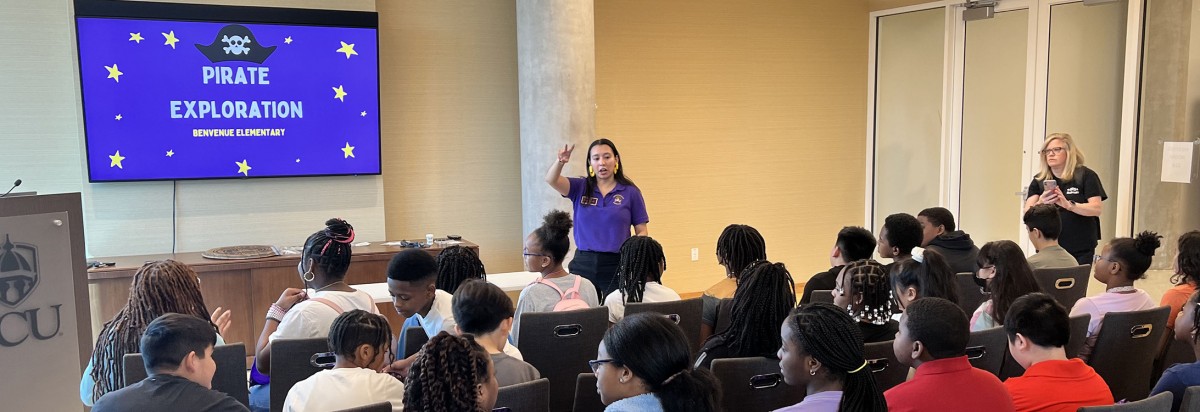Publisher's Note: This post appears here courtesy of
ECU News Services. The author of this post is
Lacey L. Gray.
 Nearly 100 fifth grade students from two North Carolina elementary schools visited East Carolina University this spring to tour the campus and learn about the educational, recreational and career possibilities available to them as future Pirates. (Contributed photo by Jean-Luc Scemama)
Nearly 100 fifth grade students from two North Carolina elementary schools visited East Carolina University this spring to tour the campus and learn about the educational, recreational and career possibilities available to them as future Pirates. (Contributed photo by Jean-Luc Scemama)
This spring, East Carolina University's Office of Undergraduate Admissions and the Thomas Harriot College of Arts and Sciences partnered to bring nearly 100 elementary students to tour the ECU campus and learn about various subjects, programs and careers they can pursue through the college.
Sixty students from Benvenue Elementary School in Rocky Mount visited campus on Feb. 15 and 22, and 30 students from Stateside Elementary in Jacksonville visited on April 19 through these Pirate Exploration days. The fifth grade students explored many areas of campus with their teachers and ECU faculty, staff and students. They participated in hands-on opportunities and learned how there is an area of study for everyone at ECU.
"The students had an amazing time. This was a great program and allowed us the opportunity to expand the minds of our students to all the career possibilities and opportunities outside of Rocky Mount that they may not have been able to see and experience otherwise," said Chelsea Wiggins, Benvenue Elementary fifth grade teacher.
Yanira Campos, former assistant director of outreach and relations for admissions, said her goal in bringing young kids to campus from surrounding rural communities was to demonstrate what is available to them at ECU.
Campos, who is a first-generation Latina college graduate, has strong connections to eastern North Carolina and received her bachelor's degree in sociology from ECU in 2016. She said many students at ECU are first-generation college students from diverse economic and socio-economic backgrounds.
"We show them college is possible for them and there are students on campus that look like them," she said.
"You'll find people here with common interests."
Jean-Luc Scemama, Harriot College's associate dean for academic programs, said another benefit of having young students visit campus is they learn about the different areas of study. He said, if one subject does not grab their interest, another field may, which then opens them up to many career possibilities down the road.
During the three campus visits, students heard from faculty, staff and graduate students from Harriot College's departments of anthropology, biology, chemistry, criminal justice and criminology, economics, foreign languages and literatures, history, physics, political science, and neuroscience studies multidisciplinary program.
ECU anthropology graduate student Chloe Scattergood discussed some of the reasons people study humans and their past. She displayed artifacts recovered from an archaeological dig site and allowed students to hold the objects while learning about their purpose.
Through the foreign languages and literatures presentation led by associate professor of German David Smith, students learned why a person may want to study another language and gain insight into other cultures and traditions, and they heard about the many study abroad opportunities available at ECU.
During Tuan Tran's neuroscience presentation, students were able to examine the brain cells of a mouse under a microscope while learning why neuroscientists study the human brain and the mechanisms of communication with the rest of the body.
Students also visited ECU's Queen Anne's Revenge (QAR) Conservation Laboratory, ECU's Eakin Student Recreation Center, the Main Campus Student Center, West End Dining Hall, Joyner Library's Special Collections room, an organic chemistry lab, and the physics particle accelerator.
"We had a great time hosting the students," said Elise Carroll, QAR conservator.
"They were making some amazing connections between history and STEM, which many adults do not even pick up on."
While exploring the library's special collections room, students examined and handled a German Bible from 1770; documents from the 1866 Freedman's Bureau indicating that a young girl would be paid for back wages she was owed in the 1850s at $4 per month; signs protesting a hog farm in Kingsboro; historical Pepsi ads; an ECU football signed by the players of the 1965 Tangerine Bowl; and pictures of ECU's previous mascots -
"Buc" the Great Dane, in 1958, and Brandy the French poodle, in 1968 - before PeeDee
"The Pirate" made his official debut in 1983.
"This was a huge eye-opener for our students. For some, it made them strive for better grades. For others, it gave them an idea of what they may want to go to college and study. For many, it carved ECU - the best university in all of N.C. - into their brains," Wiggins said.
"They'll remember this experience for a lifetime, and hopefully when it's time for college applications, ECU will remain first in their mind."

